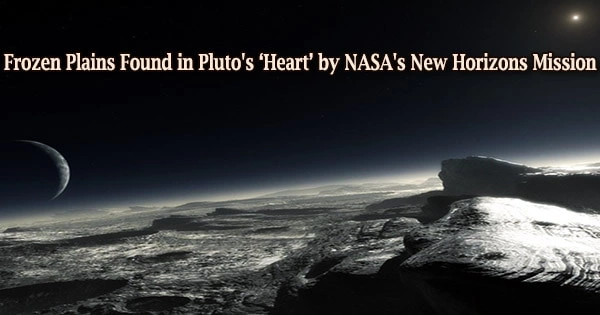A stunning close-up view of Pluto taken by NASA’s New Horizons probe depicts a wide, craterless plain that seems to be no more than 100 million years old and may still be altered by geologic processes.
This frozen region is located north of Pluto’s icy mountains, near the center-left of the heart feature, and has been dubbed “Tombaugh Regio” (Tombaugh Region) in honor of Clyde Tombaugh, the 1930 Pluto discoverer.
“This terrain is not easy to explain,” said Jeff Moore, leader of the New Horizons Geology, Geophysics and Imaging Team (GGI) at NASA’s Ames Research Center in Moffett Field, California. “The discovery of vast, craterless, very young plains on Pluto exceeds all pre-flyby expectations.”
This interesting icy plains region, which resembles Earth’s frozen mud fissures, has been dubbed “Sputnik Planum” (Sputnik Plain) in honor of the world’s first artificial satellite. It has a fractured surface with unevenly shaped parts that span around 12 miles (20 kilometers) and are flanked by shallow troughs.
Clumps of hills that appear to rise above the surrounding ground indicated some of these troughs, while others are traced by darker material.
Other parts of the surface appear to be incised by fields of microscopic pits, which could have formed as a result of a process known as sublimation, in which ice changes directly from solid to gas, similar to how dry ice occurs on Earth.
Scientists have two possible explanations for how these portions came to be. Surface materials contracting, similar to what happens when mud dries could cause uneven forms.
With the flyby in the rearview mirror, a decade-long journey to Pluto is over but, the science payoff is only beginning. Data from New Horizons will continue to fuel discovery for years to come.
Jim Green
They could also be a result of convection, similar to the way wax rises in a lava lamp. Convection would occur on Pluto, driven by the meager warmth of the planet’s interior, within a surface layer of frozen carbon monoxide, methane, and nitrogen.
Dark streaks a few kilometers long can also be seen on Pluto’s frozen plains. Winds moving across the frozen surface may have created these streaks, which appear to be oriented in the same direction.
The “heart of the heart” image from Tuesday was taken at a distance of 48,000 miles (77,000 kilometers) from Pluto, and it displays features as small as half a mile (1 kilometer) wide.
Higher-resolution and stereo photos will be pulled from New Horizons’ digital recorders and sent back to Earth within the following year, allowing mission scientists to understand more about these strange terrains.
The New Horizons Atmospheres team spotted as far as 1,000 miles (1,600 kilometers) above the surface of Pluto’s atmosphere, proving that Pluto’s nitrogen-rich atmosphere is relatively extensive. This is the first time Pluto’s atmosphere has been observed at altitudes greater than 170 miles above the surface (270 kilometers).
The New Horizons Particles and Plasma team has detected A region of cold, dense ionized gas tens of thousands of kilometers beyond Pluto, indicating that the planet’s atmosphere is being stripped away by the solar wind and lost to space.
“This is just a first tantalizing look at Pluto’s plasma environment,” said New Horizons co-investigator Fran Bagenal, University of Colorado, Boulder.
“With the flyby in the rearview mirror, a decade-long journey to Pluto is over but, the science payoff is only beginning,” said Jim Green, director of Planetary Science at NASA Headquarters in Washington. “Data from New Horizons will continue to fuel discovery for years to come.”
Alan Stern, New Horizons principal investigator from the Southwest Research Institute (SwRI), Boulder, Colorado, added, “We’ve only scratched the surface of our Pluto exploration, but it already seems clear to me that in the initial reconnaissance of the solar system, the best was saved for last.”
New Horizons is operated by NASA’s Marshall Space Flight Center in Huntsville, Alabama, as part of the agency’s New Frontiers Program. The New Horizons spacecraft was conceived, produced, and operated by the Johns Hopkins University Applied Physics Laboratory in Laurel, Maryland, which also manages the project for NASA’s Science Mission Directorate. The mission, science team, payload operations, and encounter science planning are all led by SwRI.





